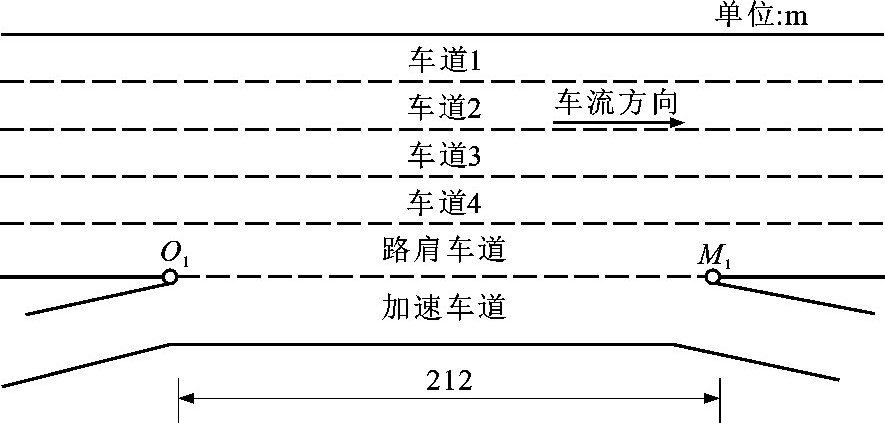Merging influence factors recognition and behaviors prediction of on-ramp vehicles of urban expressway
-
摘要: 分析了美国US101快速路瓶颈路段(简称“US101”) 和上海市延安高架上虹许路匝道瓶颈路段(简称“SHHX”) 的车辆轨迹数据, 研究了城市快速路入口匝道车辆的汇入行为; 考虑了汇入行为的13个瞬时影响因素和25个历史经历影响因素, 采用随机森林算法对38个影响因素进行重要度排序, 并识别关键影响因素; 分别对2个瓶颈路段构建了贝叶斯网络汇入行为预测模型, 并评价了模型预测精度。分析结果表明: 瓶颈路段US101和SHHX共有14个关键影响因素, 包括6个历史经历影响因素, 其中瓶颈路段US101和SHHX历史经历影响因素分别占关键影响因素总数的45.45%、36.36%, 说明汇入行为的历史经历影响因素对最终汇入决策有显著的影响; 考虑历史经历影响因素的贝叶斯网络模型预测精度较高, 瓶颈路段US101和SHHX汇入行为的总体预测精度分别提高了2.53%、8.85%, 其中未考虑历史经历影响因素时, 瓶颈路段US101和SHHX汇入行为的总体预测精度分别为87.94%和73.17%, 考虑历史经历影响因素时, 瓶颈路段US101和SHHX汇入行为的总体预测精度分别为90.47%和82.02%;此外, 预测模型无过度拟合, 测试集汇入事件与非汇入事件的预测精度之差在1.2%以内。Abstract: The vehicle trajectory data of bottleneck sections on US Highway 101 (US101) and Hongxu Road of Yan-an Expressway in Shanghai (SHHX) were analyzed, and the merging behaviors of on-ramp vehicles on urban expressway were studied.13 instant influence factors and 25 historical experienced influence factors of merging behaviors were considered. The random forests algorithm was used to sort the importances of 38 influence factors, and the key influence factors were identified. The merging behaviors prediction models based on the Bayesian network were established for two bottleneck sections, and the model prediction accuracy was evaluated. Analysis result shows that 14 key influence factors are obtained in the bottleneck sections US101 and SHHX, including 6 historical experienced influence factors. For the bottleneck sectionUS101, the historical experienced influence factors account for 45.45% of the whole key influence factors, while for SHHX, the proportion is 36.36%. Thus, the historical experienced influence factors have significant effect on the decision of final merging. The Bayesian network models that consider the historical experienced influence factors have higher prediction accuracy. The overall prediction accuracies of merging behaviors improve by 2.53% and 8.85% at US101 and SHHX, respectively. Without considering the historical experienced influence factors, the overall prediction accuracies of merging behaviors at US101 and SHHX are 87.94% and 73.17%, respectively. Under considering the historical experienced influence factors, the overall prediction accuracies of merging behaviors at US101 and SHHX are 90.47% and 82.02%, respectively. Additionally, the prediction models are not overly fitted. The difference between the prediction accuracies of merging and nonmerging events is within 1.2% using the testing datasets.
-
Key words:
- urban expressway /
- bottleneck section /
- on-ramp /
- merging behaviors /
- Bayesian network /
- historical experienced factor
-
表 1 瞬时影响因素
Table 1. Instant influence factors

表 2 历史经历影响因素
Table 2. Influence factors of history experience

表 3 关键影响因素重要度排序
Table 3. Importance degree ranking of critical influence factors

表 4 预测精度结果对比
Table 4. Results comparision of prediction accuracies

-
[1] CHEVALLIER E, LECLERCQ L. Do microscopic merging models reproduce the observed priority sharing ratio in congestion?[J]. Transportation Research Part C: Emerging Technologies, 2009, 17 (3): 328-336. doi: 10.1016/j.trc.2009.01.002 [2] BONNIN S, WEISSWANGE T H, KUMMERT F, et al. Accurate behavior prediction on highways based on a systematic combination of classifiers[C]∥IEEE. 2013IEEE Intelligent Vehicles Symposium. New York: IEEE, 2013: 242-249. [3] 左康, 刘启远, 孙剑. 城市快速路匝道汇入行为建模及仿真[J]. 系统仿真学报, 2017, 29 (9): 1895-1906. https://www.cnki.com.cn/Article/CJFDTOTAL-XTFZ201709004.htmZUO Kang, LIU Qi-yuan, SUN jian. Modeling and simulation of merging behavior at urban expressway on-ramp[J]. Journal of System Simulation, 2017, 29 (9): 1895-1906. (in Chinese). https://www.cnki.com.cn/Article/CJFDTOTAL-XTFZ201709004.htm [4] 臧志刚, 陆锋, 李海峰, 等. 7种微观交通仿真系统的性能评价与比较研究[J]. 交通与计算机, 2007, 25 (1): 66-70. https://www.cnki.com.cn/Article/CJFDTOTAL-JTJS200701017.htmZANG Zhi-gang, LU Feng, LI Hai-feng, et al. Performance evaluation and comparison of seven microscopic transportation simulation systems[J]. Computer and Communications, 2007, 25 (1): 66-70. (in Chinese). https://www.cnki.com.cn/Article/CJFDTOTAL-JTJS200701017.htm [5] SONG Rui, SUN Jian. Calibration of a micro-traffic simulation model with respect to the spatial-temporal evolution of expressway on-ramp bottlenecks[J]. Simulation: Transactions of the Society for Modeling and Simulation International, 2016, 92 (6): 535-546. doi: 10.1177/0037549716645197 [6] SUN Jie, LI Zhi-peng, SUN Jian. Study on traffic characteristics for a typical expressway on-ramp bottleneck considering various merging behaviors[J]. Physica A: Statistical Mechanics and its Applications, 2015, 440: 57-67. doi: 10.1016/j.physa.2015.08.007 [7] 孙剑, 胡家琦, 孙杰. 城市快速路交织区通行能力估计模型[J]. 中国公路学报, 2016, 29 (4): 114-122. doi: 10.3969/j.issn.1001-7372.2016.04.014SUN Jian, HU Jia-qi, SUN Jie. Capacity estimation model on weaving segments of urban expressway[J]. China Journal of Highway and Transport, 2016, 29 (4): 114-122. (in Chinese). doi: 10.3969/j.issn.1001-7372.2016.04.014 [8] 刘好德, 郑进炫, 孙剑, 等. 基于多层统计模型的城市快速路汇入区通行能力影响因素分析[J]. 公路与汽运, 2016 (5): 16-21, 24. doi: 10.3969/j.issn.1671-2668.2016.05.006LIU Hao-de, ZHENG Jin-xuan, SUN Jian, et al. Capacity influence factors analysis on merging segments of urban expressway based on multilayer statistical models[J]. Highways and Automotive Applications, 2016 (5): 16-21, 24. (in Chinese). doi: 10.3969/j.issn.1671-2668.2016.05.006 [9] YANG Qi, KOUTSOPOULOS H N. A microscopic traffic simulator for evaluation of dynamic traffic management systems[J]. Transportation Research Part C: Emerging Technologies, 1996, 4 (3): 113-129. doi: 10.1016/S0968-090X(96)00006-X [10] HOU Yi, EDARA P, SUN C. Modeling mandatory lane changing using bayes classifier and decision trees[J]. IEEE Transactions on Intelligent Transportation Systems, 2014, 15 (2): 647-655. doi: 10.1109/TITS.2013.2285337 [11] SUN Jian, OUYANG Ji-xiang, YANG Jian-hao. Modeling and analysis of merging behavior at expressway on-ramp bottlenecks[J]. Transportation Research Record, 2014 (2421): 74-81. [12] MENG Qiang, WENG Jin-Xian. Cellular automata model for work zone traffic[J]. Transportation Research Record, 2010 (2188): 131-139. [13] SUN Jian, SUN Jie, CHEN Peng. Use of support vector machine models for real-time prediction of crash risk on urban expressways[J]. Transportation Research Record, 2014 (2432): 91-98. [14] 孙剑, 蒋舜, 欧阳吉祥. 城市快速路驶入匝道瓶颈车辆汇入行为[J]. 同济大学学报: 自然科学版, 2015, 43 (4): 549-554. https://www.cnki.com.cn/Article/CJFDTOTAL-TJDZ201504010.htmSUN Jian, JIANG Shun, OUYANG Ji-xiang. Modeling the vehicle merging behaviors at urban expressway on-ramp bottlenecks[J]. Journal of Tongji University: Natural Sicence, 2015, 43 (4): 549-554. (in Chinese). https://www.cnki.com.cn/Article/CJFDTOTAL-TJDZ201504010.htm [15] KUMAR P, PERROLLAZ M, LEF S, et al. Learning-based approach for online lane change intention prediction[C]∥IEEE. 2013IEEE Intelligent Vehicles Symposium. New York: IEEE, 2013: 797-802. [16] WANG Er-gen, SUN Jian, JIANG Shun, et al. Modeling the various merging bahaviors at expressway on-ramp bottlenecks using support vector machine models[J]. Transportation Research Procedia, 2017, 25: 1327-1341. doi: 10.1016/j.trpro.2017.05.157 [17] HOU Yi, EDARA P, SUN C. A genetic fuzzy system for modeling mandatory lane changing[C]∥IEEE. 2012 15th International IEEE Conference on Intelligent Transportation Systems. New York: IEEE, 2012: 1044-1048. [18] HOU Yi, EDARA P, SUN C. Situation assessment and decision making for lane change assistance using ensemble learning methods[J]. Expert Systems with Applications, 2015, 42 (8): 3875-3882. doi: 10.1016/j.eswa.2015.01.029 [19] MARCZAK F, DAAMEN W, BUISSON C. Key variables of merging behaviour: empirical comparison between two sites and assessment of gap acceptance theory[J]. Procedia-Social and Behavioral Sciences, 2013, 80: 678-697. doi: 10.1016/j.sbspro.2013.05.036 [20] MIGLETZ J, GRAHAM J L, ANDERSON I B, et al. Work zone speed limit procedure[J]. Transportation Research Record, 1999 (1657): 24-30. [21] BREIMAN L. Random forests[J]. Machine Learning, 2001, 45 (1): 5-32. doi: 10.1023/A:1010933404324 [22] REIF D M, MOTSINGER A A, MCKINNEY B A, et al. Feature selection using a random forests classifier for the integrated analysis of multiple data types[C]∥IEEE. 3rd Computational Intelligence in Bioinformatics and Computational Biology Symposium. New York: IEEE, 2006: 171-178. [23] SUN Jie, SUN Jian. A dynamic Bayesian network model for real-time crash prediction using traffic speed conditions data[J]. Transportation Research Part C: Emerging Technologies, 2015, 54: 176-186. doi: 10.1016/j.trc.2015.03.006 [24] 周涛, 翟长旭, 高志刚. 基于贝叶斯网络的高速公路预警系统研究[J]. 公路工程, 2007, 32 (4): 163-166. https://www.cnki.com.cn/Article/CJFDTOTAL-ZNGL200704040.htmZHOU Tao, ZHAI Chang-xu, GAO Zhi-gang. Study on the forewarning system of freeway based on Bayesian networks[J]. Highway Engineering, 2007, 32 (4): 163-166. (in Chinese). https://www.cnki.com.cn/Article/CJFDTOTAL-ZNGL200704040.htm [25] DING Wei, SONG P X K. EM algorithm in Gaussian copula with missing data[J]. Computational Statistics and Data Analysis, 2016, 101: . -





 下载:
下载:








